Old Material…New Material
 Table of Contents: February 2018 — Arts, Social Change, and a Vision for Sustainability
Table of Contents: February 2018 — Arts, Social Change, and a Vision for Sustainability
Turner JSE February 2018 Arts Issue PDF
Introduction
In a climate of concern for the natural world many academic disciplines focus on, or at least examine the topic of environmental sustainability. For instance, the Association for Advancement of Sustainability in Higher Education shows a total of 765 institutions with a rating in the Sustainability Tracking, Assessment & Rating System. Yet, while so many disciplines teach the topic of sustainability how many do so in a sustainable manner? As Parker (2012) indicates:
“While colleges and universities are often at the forefront of major social changes, and while it is true that academics have contributed a great deal to our overall understanding of the need for sustainability, the commercial and public sectors have, in many respects, outrun education in making their day-to-day operations more sustainable.” (p. 1)
Indicatively, data generated by Conservatree reveals that roughly 8,333.3 sheets of standard copy paper can be made from one tree, meaning that an educator who prints a five-page syllabi for a class of 50 students consumes 3% of one tree. While this may seem minimal consider that most educators provide syllabi along with handouts, tests, and assignments for multiple sections or courses per semester, alongside innumerable educators on campus. Paper consumption associated with higher education has the potential to escalate exponentially. In fact, the Office of Sustainability at Boston College suggests that one college student, on average, creates 320 pounds of paper waste per year.
Such statistics provide the stimulus for some universities to initiate operational efforts, organizations and committees focused on reducing their institution’s carbon footprint. Ann E. Savageau (2013), however, contends that the success in reducing consumption, waste, and greenhouse gas emissions, ideally requires a university-wide shift, that includes faculty, staff, and students. In an interview by Pramod Parajuli and Rosemary Logan for The Journal of Sustainability Education (2011), Jamie Cloud describes contributions from the field of neuroscience to Education for Sustainability (EfS) through the understanding that: “Thinking drives behavior, and behavior causes results. If you don’t like the results, the most upstream place to intervene is the thinking.” Hence, educators have the potential to reflect on and alter pedagogical thoughts and practices to incorporate environmental approaches with the potential to catalyze a shift in the way others think and behave. Universities like Duke, American University, and the University of Pennsylvania already offer green teaching certificates as a means of encouraging and educating faculty on sustainable practices, but even without this support faculty have the opportunity to be a catalyst for change. As a primarily visual and visceral practice that is inextricably connected to the environment design education paradoxically often uses more materials and resources than the standard copy paper or textbook for communicating ideas, presenting it as a unique case study with accessible and transferable results.
Framework
The design process and the act of designing is not linear, it is cyclical and iterative. It represents a methodology for analyzing and solving complex problems, which often relies on making or creating as a means of ideation and communication. Resulting from the simultaneous biological development of the human hand and brain the act of thinking and making are inextricably connected (Somerson et al. 2013). This contributes to the reason designers sketch, through various stages of detail, as a method of depicting critical thought, solving problems, and communicating. Similarly, oscillating between thought and action designers express ideas three-dimensionally through models and model making. Related to the innate human desire to experience through touch making models becomes a practice of ideation with constructed realities to understand three-dimensionality, scale, proportion, material, etc. (Konkel 2014). Hence, “the artistic mind relies on ‘making’ as a critical activity, one that informs a particular kind of deep intelligence that cannot be learned without real material manipulation and sensory, embodied experience” (Somerson et al. 2013, 22). Discernably, most of these processes require the use and consumption of materials and resources, creating a sustainability challenge for design educators in determining how to teach then evaluate their students’ work. Students ideate through sketches meant to fill pages of a sketchbook while creating inspiration boards and boundless iterations of study models. Throughout the duration of a studio project students present process and schematic work with sketches, renderings, models, or printed “boards”. The culmination of these projects comes at a juried review that places emphasis on large-scale, printed, graphical presentations as the sole tool for evaluation, a pedagogical framework shaped by long-standing Ecole des Beaux Arts and Bauhaus traditions (Cret, 1941, Gurel, 2004). Yet, ironically, a gross majority of the physical materials utilized in the design process and presentation enter the waste stream in favor of digital versions for online portfolios.
In response, an inquiry-based collection, documentation, exhibition and repurposing of discarded materials waste from a studio course, embodied an expanded definition of sustainability as it relates to the design process and practices. Referencing the “Model-Making and Waste Management” program by Cook (2015) at the University of Texas at Austin, which focused solely on collection of waste from fabrication of physical models, this exhibit encouraged design educators and students to notice and question the waste created throughout the process of design. Rather than disposing of material waste students of one studio course, in one interior design program, at the end of one semester, were asked to collect anything used during the design process (See Figure 1).
While not exhaustive because these materials were only collected in one of four studio levels and only at one semester’s end, the accumulation represented the amount of resources design education consumes and how much it potentially contributes to the waste stream. Collected materials were then sorted and weighed. The result was 118.4 pounds of materials and supplies, including the large-scale printed boards, syllabi and assignments, markers, push pins, rulers, foamcore, finishes, plastic bags, and material boards (see Table 1).

Figure 2: Panoramic photograph of the exhibition to indicate experience as it coincides with the design process and material use, from concept to presentation and after.
Source: Author, 2016
Design students and faculty happen upon an open door,
the room for a materials library now reveals more.
Greeted by an illuminated studio desk and instruments of ideation,
an experience of the design process exposes materials as the foundation.
Abstracted precedent merge with sketches and notes on trace,
slowly converging with media that makes to engender place.
Enter model pieces and parts; create, critique, revise, repeat.
An amassing of ideas climb the adjacent wall until the ceiling they meet.
Materials swell with elevated ideas meandering overhead,
digital drawings, models, and materials add to the symbolic visual thread.
Consideration of critique give graphics and spaces more clarity,
as furniture, fixtures, equipment, and finishes provide each idea singularity.
Aloft materials catalyze a deconstructed presentation board,
pristine plans, details, and three-dimensional renderings all adored.
Quickly discarded in favor of a digitized version,
waste receptacles become the site of their perversion.
The Exhibit
To create a visual expression of this narrative and render new insights on educational design practices associated with environmental sustainability the exhibit placed emphasis on process over product, wherein installation metaphorically progressed as an experience of design. Strategically located in a frequently visited room that housed the program’s material library it wasn’t until the “opening” that passerby gained knowledge of its genesis or meaning. This purposeful veiling also served as commentary and exemplification of the student populations’ lack of knowledge and apathetic attitude toward sustainability. Similar to notions offered by Savageau (2013), a survey by Ruff and Olson (2009) of 95 students in all levels of a state-supported interior design program indicated that, “the majority of respondents think the Earth is limitless and can endlessly renew itself,” or, “that the Earth had plenty of natural resources,” and they “place great faith in the Earth’s ability to rebound from Human abuse” (p.75-76). The same survey respondents dominantly indicated “recycling” as a way to demonstrate “understanding of sustainable methods and products” (p.75-76). While recycling is certainly one means of sustainability the exhibit intended to expand student and faculty perceptions by exposing material consumption and encouraging waste mitigating strategies. For instance, drawings and presentation boards (printed only on one side) provide the physical and symbolic support for the exhibition and staples were the only material used that was not collected during the studio cleanout. Additionally, most materials used in the creation of the exhibit were carefully cut for reuse once it was deconstructed (See Figure 3).
Experience of the exhibit was initiated by a typical design studio desk near the room’s entrance that was topped with materials and supplies associated with ideation and the beginning of the design process. Emblematic of idea evolution and concept development these materials slowly dematerialized and transitioned to graphics and diagrams that ascended the adjacent wall and continued the transition of design phases. Becoming more deeply involved the viewers had to alter their posture to look up as they were engulfed by materials that accumulated and expanded overhead, symbolizing the concretization of ideas (See Figure 4).
Supplies associated with the creation of models added to the visible discourse, while rough schematic plans developed with inclusion of fixtures, furniture, equipment, lighting, and finishes. Typifying the emphasis often placed on large-scale final design presentations the aloft materials assembled an abstract presentation board boasting three-dimensional renderings, plans, elevations, and finish selections. Then, mimicking the ways in which these large printed boards and physical materials are often discarded in favor of deconstructed versions for a digital portfolio, the exhibition eroded into a trashcan. Evoking inquiry about the amount of physical materials the design process contributes to the waste stream, viewers were encouraged to peer inside the receptacle (See Figure 5).
Not readily visible, a graphic inside provides information on the amount of waste diverted from a landfill on account of the exhibit’s collection while illustrating its equal in terms of trees, water, oil, and electricity consumption (See Figure 6).
Closely situated next to the trashcan was a grouping of drafting tables which posed a response and potential strategies for integrating sustainability into design pedagogy. Labeled “give, take, make”, a permanent station meant to indefinitely extend the visual narrative of the exhibition encouraged students and faculty to donate materials for re-use, but also take materials to make something new. Scraps from the building of models sat at the ready alongside rolls of discarded presentation boards as well as buckets of textiles and wallcovering (See Figure 7).
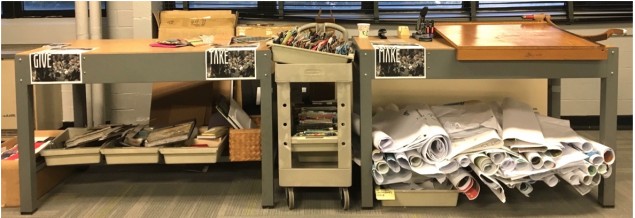
Figure 7: Give, Take, Make Station with inspiration books and collected materials not used in the exhibition.
Source: Author, 2016
Revealing their potential these old materials achieved new life as “inspiration books” with covers made of a textile or wallcovering sample and pages created from one-side printed presentation boards, including those composing the exhibit, so users could be in constant contact with materials and previous ideas as they sketch new concepts or take notes (See Figure 8).
Upon exiting the exhibit and the room one of these inspiration books could be seen lying amongst the clutter on the studio desk that greeted visitors. Closing the loop a minor detail that may have initially gone unnoticed found new meaning and signaled a revived lens for rethinking the use and reuse of materials in design education.
Results
Insights garnered from the collection, documentation, exhibition and repurposing of the discarded materials mobilized experiments to integrate environmental practices into design courses, wherein learning and deliverables truly reflect the values and discourse of sustainability. Firstly, students in studio and support courses were required to use the inspiration books generated by the exhibit instead of purchasing new sketchbooks. They were simultaneously encouraged to use the materials collected, in addition to donating any of their own residual materials, as opposed to throwing them away. Pedagogically, cardboard collected from a local recycling center was required for use in various stages of a design studio project. This presented benefits and challenges in that it successfully expressed the desired notion and actions relating to sustainable design practice. However, it also brought limitations in the creation and expression of ideas on account of material properties. In response, a subsequent studio project instead required the students to choose and use various found materials, including those collected for the exhibition, that were suitable for the project purpose and intent (See Figure 9).
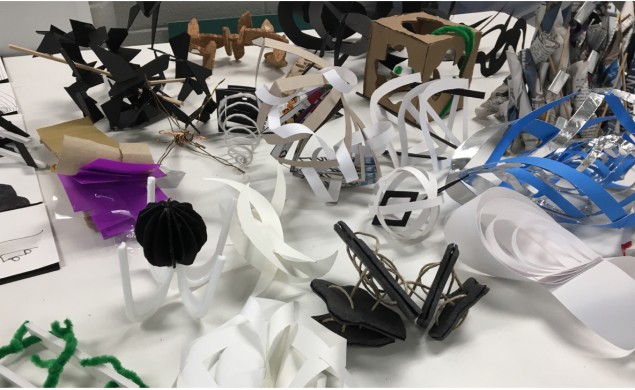
Figure 9: Conceptual models created by the 2017 Fall semester 1st year studio utilizing materials from the Give, Take, Make Station along with other reused and/or found materials.
Source: Author, 2017.
As an extension of this exercise and implementation students have continued to use, donate, and repurpose materials throughout the duration of studio projects, even focusing on broader issues of sustainability in concept and design development. Because of this, the giving and taking of materials has become an integral part of the permanent materials library and a cornerstone of studio clean-out days at the end of each semester as well as a highlight of studio professors and courses in the introduction of new projects and phases of the design process.
Aligned with more typical resources in higher education, green teaching strategies focused on reduction were also incorporated in various courses throughout the design program. One introductory method included utilization of the Learning Management Systems and digital means to share syllabi and course related material, instead of printing. This notion then expanded to the utilization of Online Educational Resources, or digital options, rather than requiring textbooks or printed readings. The United Nations Education, Scientific and Cultural Organization (UNESCO), open educational resources (OERs) are universally accessible teaching, learning, or research materials within the public domain, and they provide educators with a range of more current information by diverse scholars. When OERs were utilized in a third-year Interior Finish Materials course with a hybrid framework one student anonymously commented that their favorite part about the course was: “The interactiveness. Rarely a repeat day, which makes it fun + I pay attention + learn more.”
Further, capturing and capitalizing on the wealth of information online enabled rethinking course components and content. For instance, one student in a first-year History and Theory course with a multimodal delivery style noted: “I learned how to look at things different. The material and teaching style of this course was great and I feel that I learned a lot.” This student “experienced” the Roman Colosseum first through a video-recorded lecture created by the instructor, followed by exploration of two websites, both allowing for virtual and self-directed, 360 degree tours of the Colosseum: one in ancient times from a gladiator’s perspective (http://74.220.219.72/~thrdhis1/GladiatorsiPad.html), and the other in its current state (http://www.airpano.ru/files/Italy-Rome-Colosseum/2-2).
In addition to existing online content there are sites that have the potential to reduce waste while aligning educational tactics with 21st century interests by engaging students as curators. The Pew Research Center conducted a report in 2015 on social media usage and determined that 90% of Americans age 18-29 as well as 77% of Americans age 30-49 use social networking sites (Perrin, 2015). Pinterest is an image-centered platform that allows for various modes of learning and sharing. Incorporated in two different course with distinct intentions multiple class boards were created with students as “collaborators”. Weekly posts that focused on imagery and limited text, took the place of weekly reflections or responses to course content (https://www.pinterest.com/helen2868/in-a-material-world/), while also acting as an alternative method for curating and sharing research with group members and classmates (https://www. pinterest.com/helen2868/water/). Both boards were easily accessible for every student and, in another facet of sustainability, the work lived beyond the semester for successive use while exposing it to a broader network. Of this method, one student anonymously commented in a course evaluation: “Awesome job implementing new research techniques like pintrest!”
Conclusion
The creative expression and consequential paper is not a promotion for drastically altering design education or disavowing the validity and necessity of iteration or making, but to encourage new modes for thinking and doing in consideration of materials used and discarded throughout the process. Transition from a convention of material use and disposal to a culture of sustainability is not a quick process, but an evolution through phased implementation of awareness and action. Hence, the intention of the exhibit was to engage design faculty and students by stimulating meaningful reflection and response while serving as a catalyst for creation of expanded ideas, explorations, and implementations. A potential extension of this exhibition lies in investigation of embedded concepts on a variety of scales as a means of deepening mindfulness, like simultaneously collecting materials at all levels of studio or over the course of a year instead of a singular semester, or asking students to collect, track, and creatively document their personal material waste. Ideally, these ideas, the benefits, and best practices could then serve as precedent for other departments and disciplines. As this paper also provides some digital methods for reducing physical waste, it would be beneficial and interesting to conversely explore the waste associated with consumerism and digital technology as a material of design education.
Regardless, the understanding of “sustainability” needs to extend beyond final products to include both process and practice. Such efforts have important implications for social and economic sustainability in terms of student equity and accessibility to information and resources for an increasingly heterogeneous student population that, according to Miller, Valle, and Engle for the Institute for Higher Education Policy (2014), includes students of varying income levels who are potentially attending school part-time, commuting to campus, non-traditional in age, caring for dependents, working full-time, or are active duty military or veterans. With this, it is apparent that educators have the opportunity to rethink the ways in which students are prepared for the professional world and how to provide orientation for environmental stewardship. Hence, sensibilities and methods of practice associated with sustainability should be embedded as a cultural norm, providing students with an opportunity for deeper learning and application. A discipline, like design, that incorporates and promotes the principles of sustainability should also be an embodiment of sustainable methods…to practice what it teaches.
Acknowledgements
This work would not have been possible without the effort, time, and imagination of graduate student Katie Bryn Wilborn and undergraduate student Karsyn Rohach or the work from the 2016 Spring semester 4th year studio and 2017 Fall semester 1st year studio as well as support from all School of Interiors faculty in the College of Design at the University of Kentucky.
References
American University. (2017). Green Teaching. Retrieved from http://www.american.edu/ctrl/green.cfm.
Association for the Advancement of Sustainability in Higher Education. (2016). STARS Participants & Reports. Retrieved from https://stars.aashe.org/institutions/participants-and-reports/.
Boston College Office of Sustainability. (2017). Know Your Facts. Retrieved from https://www.bc.edu/offices/sustainability/what-you-can-do/know-facts.html.
Conservatree. Trees Into Paper. Retrieved from http://conservatree.org/learn/EnviroIssues/TreeStats.shtml
Cook, W. 2015. “Model-Making and Waste Management in the UT School of Architecture.” Sustainability on the UT Campus: A Symposium. Retrieved from https://sustainability.utexas.edu/documents/Model-Making_WarnerCook.pdf
Cret, Paul P. 1941. “The Ecole des Beaux-Arts and Architectural Education.” Journal of the American Society of Architectural Historians 1(2), 3-15.
Duke University. Green Classroom Certification. Retrieved from http://sustainability.duke.edu/action/certifications/classroom/index.php.
Gurel, M.O., and I. Basa. 2004. “The Status of Graphical Presentation in Interior/Architectural Design Education.” International Journal of Art & Design Education. 23 (2): 192-206.
Konkel, M.T. 2014. “Build-to-Learn: An Examination of Pedagogical Practices in Interior Design Education.” Journal of Interior Design 39(2): 1–16.
Miller, A., K. Valle, and J. Engle. 2014. “Access to Attainment: An Access Agenda for 21st Century College Students.” Institute for Higher Education Policy. Retrieved from http://www.ihep.org/research/publications/access-attainment-access-agenda-21st-century-college-students.
Pajuli, P., and R. Logan. 2011. “How our Teaching Changes our Thinking, and How our Thinking Changes the World: A Conversation with Jaimie Cloud,” The Journal of Sustainability Education. Retreived from http://www.susted.com/wordpress/content/how- our-teaching-changes-our-thinking-and-how-our-thinking-changes-the-world-a-conversation-with-jaimie-cloud_2011_05/.
Parker, K. (2012). Introduction: Sustainability in Higher Education. In K. A. Bartels and K. A. Parker (Eds.), Teaching Sustainability / Teaching Sustainably. Stylus Publishing.
Perrin, A. (2015). Social Media Usage: 2005-2015. Pew Research Center, Internet & Technology. Retrieved from http://www.pewinternet.org/2015/10/08/social-networking- usage-2005-2015/.
Ruff, C.L., and M. Olson. 2009. “The attitudes of interior design students towards sustainability.” Journal of Technology & Design Education (19): 67-77.
Savageau, A. (2013). “Let’s get personal: making sustainability tangible to students.” International Journal of Sustainability in Higher Education. 14(1): 15-24.
Somerson, R., and M.L. Hermano. 2013. The Art of Critical Making. Hoboken, NJ: John Wiley & Sons, Inc.
United Nations Educational, Scientific and Cultural Organization. (2017). Open Educational Resources. Retrieved from http://www.unesco.org/new/en/communication-and-information/access-to-knowledge/open-educational-resources/.
University of Pennsylvania. 2017. Green Teaching Guide. Retrieved from https://www.sustainability.upenn.edu/guides-manuals/green-teaching-guide.








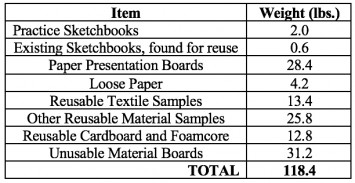

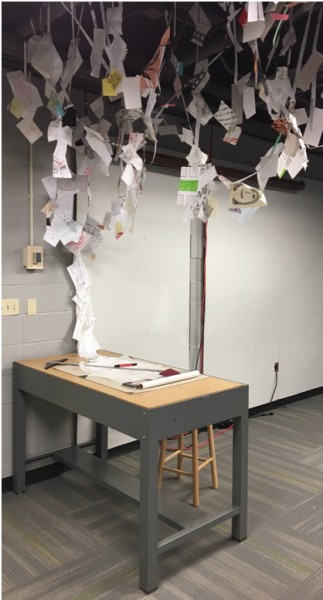


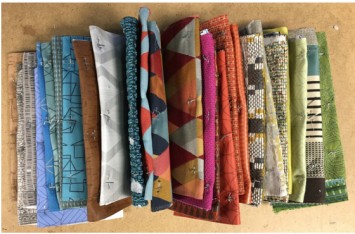



 With a Master of Science in Architecture from the University of Cincinnati and a Bachelor of Science from Ohio University, Helen Turner is also NCIDQ certified and a LEED accredited professional with over four years of professional design experience. As a faculty member in the School of Interiors at the University of Kentucky, she has taught all levels of studio and a variety of support courses. Utilizing her interests and experiences in history, sustainability, materials, and theory as a unique framework for conducting research, pedagogy, and service, Helen’s main focus is on “materials” and various interpretations of the term as a means of expressing the ways in which design adds value to environmental experiences.
With a Master of Science in Architecture from the University of Cincinnati and a Bachelor of Science from Ohio University, Helen Turner is also NCIDQ certified and a LEED accredited professional with over four years of professional design experience. As a faculty member in the School of Interiors at the University of Kentucky, she has taught all levels of studio and a variety of support courses. Utilizing her interests and experiences in history, sustainability, materials, and theory as a unique framework for conducting research, pedagogy, and service, Helen’s main focus is on “materials” and various interpretations of the term as a means of expressing the ways in which design adds value to environmental experiences. 
